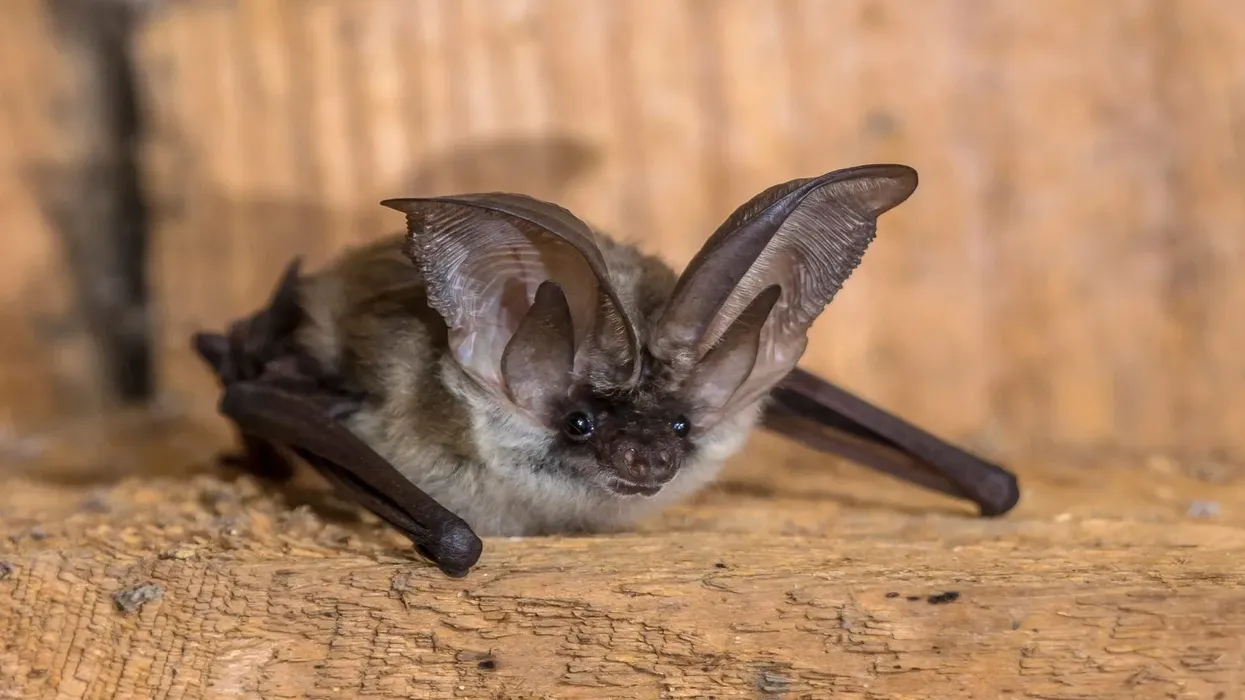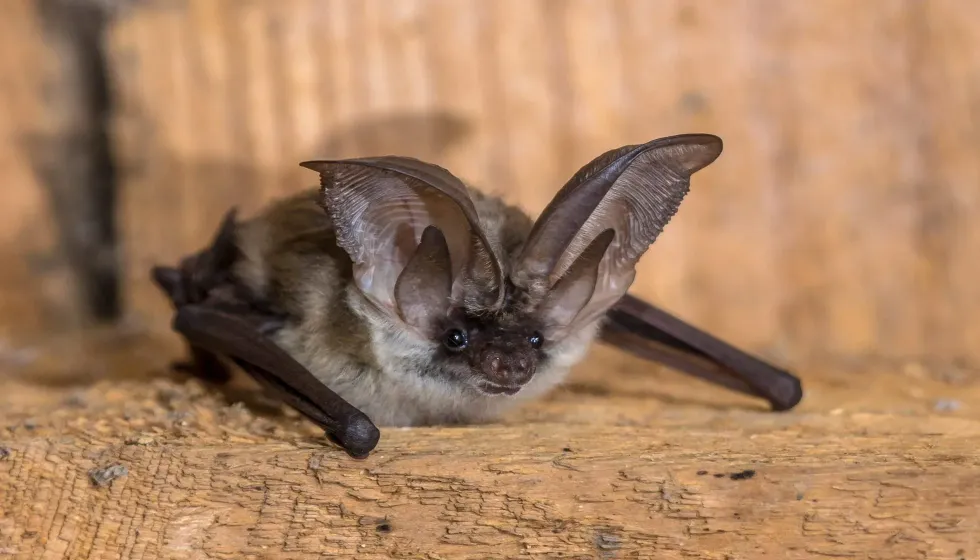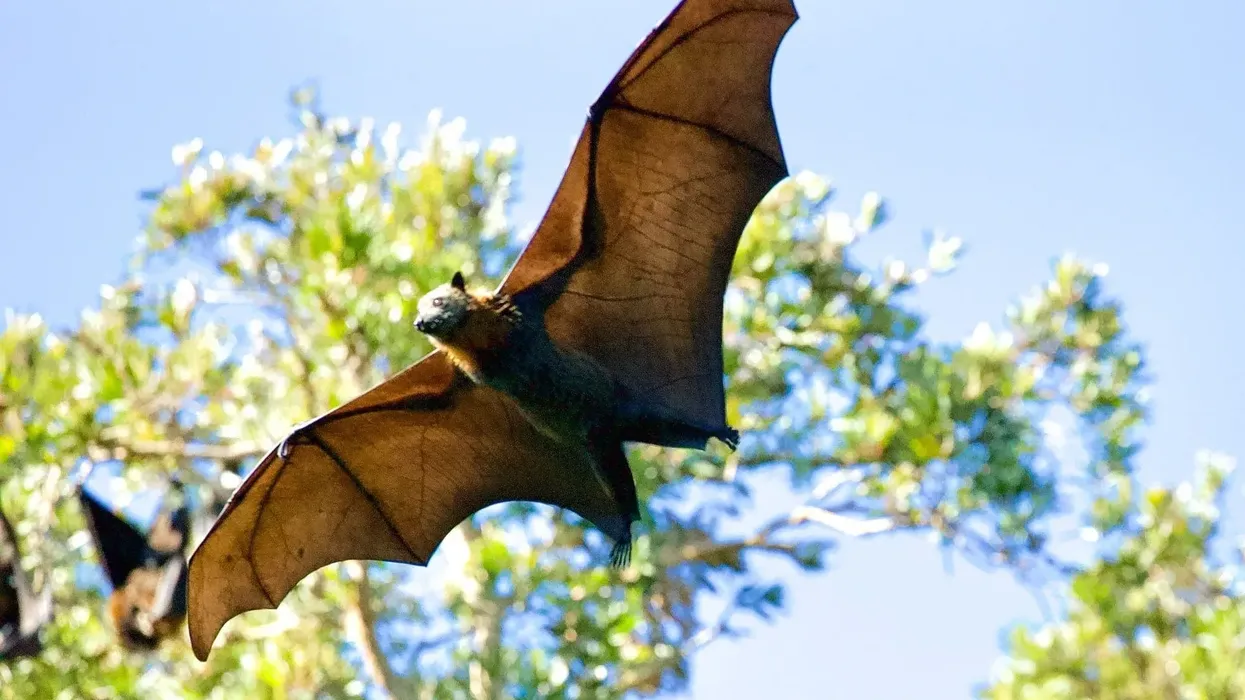A rare form of grey long-eared species is found in Britain and is so similar to the brown long-eared species that it is difficult to differentiate between the two. While talking about the morphological features of grey long-eared bats, the fur is usually long.
Its dorsal fur is medium to dark grey with a hint of brown color, whereas the ventral fur is a pale grey. Its ears are longer than 1.18 in (30 mm) and around three-quarters of the length of the head and ****.
The only feature that distinguishes grey long-eared bats from other bats is the width of the tragus. The tragus of grey long-eared bats is 0.1 in (5 mm) at its widest point.
Another ambiguous point between the two species of bats is that the brown long-eared juveniles have grey fur until about a year.
The only similarity between both species of bats is that they fold their ears beneath their wings during sleep and the period of hibernation. During this time, only the tragus gets exposed.
Their flight is usually near the ground level. Due to their broad wings, they are highly maneuverable.
Their prominent feature is their long ears which make them recognizable even as they fly by. So, if you find grey long-eared bats interesting, you can also refer to our articles on hoary bats and red bats.
Grey Long-Eared Bat Interesting Facts
What type of animal is a grey long-eared bat?
Grey long-eared bats are the rarest bats in Britain. They look like brown long-eared bats and, it can be challenging to tell the two species separately.
What class of animal does a grey long-eared bat belong to?
The grey long-eared species belong to the class of mammals.
How many grey long-eared bats are there in the world?
The distribution of the long-eared Plecotus austriacus in England is around 1,000–1,500. The population trend around the world is unknown.
Where does a grey long-eared bat live?
It feeds above woodlands, grasslands, marshes, meadows, and gardens.
What is a grey long-eared bat's habitat?
Grey long-eared bat's habitat for prey is lowland meadows, marshes, warm valleys, and small, open woodland. You can spot them in the south and southeast part of England.
Who do grey long-eared bats live with?
The breeding colonies of grey long-eared bats **** in roosts during April and May. Usually, numbers are low, around about 20 adults. But clusters of up to 100 are documented. Females bats often accept male bats in roosts.
As far as facts regarding roosts of bats are concerned, there are two types of roosts. Summer roosts are recorded in attics of old houses and churches, similar to sites used by brown long-eared bats. Winter roosts are usually seen in underground sites such as caves, tunnels, and cellars.
How long does a grey long-eared bat live?
The baby Plecotus is born in June or July of England. The **** average age recorded is 14.5 years.
How do they reproduce?
Members of this species store **** and practice delayed conception. The copulation takes place in the fall. Ovulation and fertilization follow in the next spring.
The young ones are born in early summer. They have sufficient time to build ample **** from weaning to stay alive in the winter. The mother and offspring stay in their roost during the developmental stage that is for July and August.
What is their conservation status?
This species of bats comes under the category of Near Threatened by the IUCN. It has a wide geographical range and is moderately common.
A 2013 study has shown that this species was near to extinction in the United Kingdom. A conservation project named Back from the Brink is currently focusing on how to conserve the habitat around known roost sites.
Grey Long-Eared Bat Fun Facts
What does a grey long-eared bat look like?
The population of grey long-eared bats is one of the rarest mammals in Britain. They look similar to brown long-eared bats. Generally, grey long-eared bats have a darker face and broader tragus (than brown long-eared bats.
Their fur is more grey in color. This is usually misleading because brown long-eared juveniles are grey until about a year old. The grey long-eared bat wingspan ranges from 8.7–10.6 in (22.2–26.9 cm).
How cute are they?
It is a cute furry mammal as compared to ghost bats.
How do they communicate?
It uses tactile and chemical senses as perception channels.
How big is a grey long-eared bat?
An average length of grey long-eared adult bat lies in the range of 1.6-2.2 in (4.1-5.8 cm), whereas Kitti's Hog-nosed Bat grows up to 1.1-1.3 in (2.9-3.3 cm). Therefore they are almost of the same size.
How fast can a grey long-eared bat move?
These bats have a swift and skillful flight 6.5-16.4 ft (2-5 m) above the ground level.
How much does a grey long-eared bat weigh?
The weight of the long-eared bat (Plecotus austriacus) can range between 0.24-0.49 oz (7-14 g). They are two times lighter than the big brown bat.
What are the male and female names of the species?
Both male and female special is known as Plecotus austriacus.
What would you call a baby grey long-eared bat?
A baby grey long-eared bat is called a pup.
What do they eat?
The grey long-eared bat usually preys on a variety of insects and reptiles, including Lepidoptera (62–67% of the diet), followed by Diptera (21–32%). The lepidopteran species consist of eared-moths of the family Noctuidae (70%), while Tipulidae (crane flies) is the most common dipteran family (76%).
The residual prey orders (Neuroptera, Hemiptera, Coleoptera, **** Trichoptera, and Isopoda) add to less than 5% of the food regime.
Are they aggressive?
All long-eared bats (Plecotus austriacus) try to avoid humans and are not aggressive. Most bats use their teeth and weak jaws to pick on insects.
Less than one-hundredth of the bat population contracts rabies, which may be a much low rate of incidence than other mammals. Still, you ought not to disturb bats, especially those who are active and appear sick during daylight.
Would they make a good pet?
No. The long-eared bat (Plecotus austriacus) is a wild animal and cannot be domesticated as a pet.
Did you know...
The long-eared grey bat carries rabies. However, you would be more prone to get rabies from an unvaccinated dog than from a bat. Wash all the bat bites instantly with soap and water. Consult your physician as soon as possible.
Why do they have long ears?
A prerequisite for bats is the sharp hearing ability that helps them to echolocate. It means that they can sense the echo of the sound waves they emit to find and hunt their prey. Large ears escalate air resistance, hence forcing them to spend more energy than species with small ears.
Is the grey long-eared bat endangered?
This species does not come under the category of endangered animals in the UK Biodiversity Plan. According to IUCN Red List, it is classified as the Least Concern species.
Here at Kidadl, we have carefully created lots of interesting family-friendly animal facts for everyone to discover! Learn more about some other mammals from our spectral bat facts and giant golden-crowned flying foxes facts pages.
You can even occupy yourself at home by coloring in one of our free printable grey long-eared bat coloring pages.










